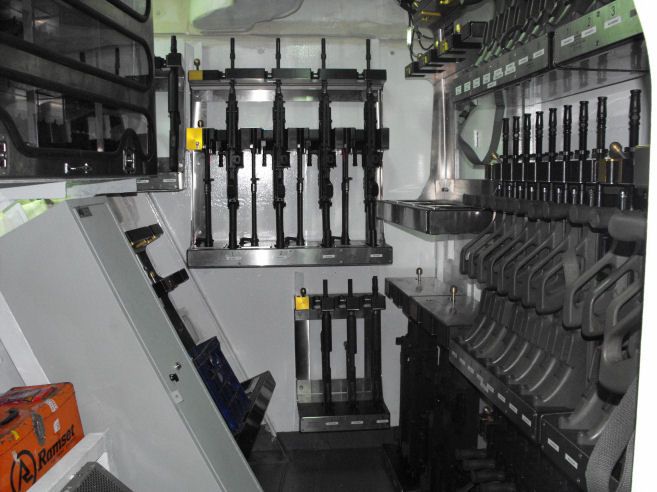
The Evolution of floating armouries
The decision by governments in the HRA to remove potentially insecure or destabilising stockpiles of weapons from their territory, alongside contractors wanting ready access to arms and ammunition and the limited capabilities of states to provide armed security for individual vessels, led to the evolution of floating armouries.
Aside from weapons and ammunition, they provide additional logistical support such as medical facilities and short-term accommodation.
The term “logistic support vessel” is sometimes used instead of “floating armoury”. Floating armouries are not purpose-built vessels but adapted craft ships that are converted and retrofitted with questionable safe and secure storage for arms and ammunition. At present, there is nothing to prevent any vessel being turned into an armoury and moored in international waters.
The armouries include ships that were previously offshore tugs, anchor handlers, research vessels, patrol boats, roll on-roll off ferries and a navy de-mining ship.
Floating Armoury Operators
Based on an extensive survey of FA operators and customers by the United Nations Office on Drugs and Crime (UNODC), at the peak of FA operations, roughly 10-12 operators and around 20 vessels supported as many as 2,500-3,000 PCASP embarkations/ disembarkations across the HRA each month.
As of September 2018, it is currently estimated that there are currently around 1,500-1,800 embarkations/ disembarkations across the HRA each month. FAs also started to provide accommodation for PCASP on board their vessels for the period in between their transits across the HRA. A number of FAs continue to operate in the Red Sea and Gulf of Oman as “Floatels” for PCASP.
The main concentration of armouries are located in the Red Sea, Gulf of Oman and the Indian Ocean. Floating armouries are located at either end of the piracy affected zone, allowing operators to both pick up and drop off weapons outside the HRA and also out of territorial jurisdiction.
The Challenge
A lack of law and regulation on both national and international levels governing the operation of floating armouries poses a significant challenge to regulators and policy makers. Who have struggled to keep pace and adapt to the evolution of floating armouries.
For example: The UN Monitoring Group on Somalia and Eritrea fears a lack of monitoring and regulation creates opportunities for unscrupulous actors to exploit. They believe floating armouries and PMSCs pose a threat to regional peace and stability rather than the solution.
No centrally managed, publicly available register of floating armouries exists which makes it difficult to ascertain the exact number of armouries in operation, and evaluate the challenge they pose.
Vessels used as floating armouries are registered to a variety of ‘flag states’, while the company operating the vessel may be registered to a different country. Problems arise if the flag state has limited controls over the storage and transfer of military equipment, and the company’s home state has no extraterritorial brokering controls on the weapons. Even if the home state does have extraterritorial controls it may have no knowledge that companies registered under its jurisdiction are operating floating armouries. In the early days of FAs, operating companies were able join organisations such as the Security Association for the Maritime Industry (SAMI) and become certified members through a security and compliance programme. However, this organisation is now dissolved.
Companies operating FAs can also implement the applicable ISO standards, however these are optional steps and the standards relate to PMSC’s rather than floating armouries.
Although the number of piracy attacks has decreased the number of floating armouries and the number of PMSCs working in the area remains high. At present the only way in which the number or armouries and companies operating in the HRA will be decreased is through pressure from market forces i.e. the number of commercial contracts offered by private vessel owners to provide security during transits decreases. The use of floating armouries and the growth of PMSCs raises important questions regarding the regulation of emerging security actors, in particular the oversight mechanisms in place to monitor and regulate these new developments.
In other regions such as West Africa and South Asia where threats to commercial shipping are on the increase the PMSC market continues to grow.

Focus on Malta: Is change coming?
The Maltese authorities have changed their stance on Floating Armouries and have added a line of text to the EUC’s issued by them stating “Weapons/ammunition cannot be loaded on any floating armoury”.
With over 80% of the transits that maritime security companies undertake either starting or ending on a floating armoury, this is a major change in operations or at least administration for security companies. It is also a major change for the different floating armoury operators in the region as most will find that their operations no longer comply with the terms under which the EUC’s are issued.
Malta, has since the early days of maritime security, been the main provider of arms to the industry and it is estimated that over 60% of the weapons currently used by Maritime Security companies originate from the country.
This also means that many of the “End User Certificates” (EUC’s) are also issued by the Maltese authorities.
An EUC’s is one of the primary documents that ship owners and managers check when deciding to book service from a maritime security company. The EUC must be valid and belong to the security company they contract for the job.

